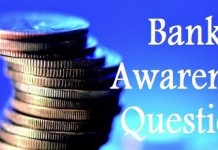Hello Aspirants. Welcome to Banking Awareness Quiz in AffairsCloud.com. Here we are creating quiz covering important questions which are common for all the bank exams and other competitive exams.
- Rate at which the domestic currency can be converted into foreign currency and vice-versa is known as _______.
A. External Value
B. Exchange Rate
C. Spot Rate
D. Interest RateB. Exchange Rate
Explanation:An exchange rate represents the relative price of two currencies. For example, the dollar–euro exchange rate implies the relative price of the euro in terms of dollars. If the dollar–euro exchange rate is $0.95, it means that you need $0.95 to buy €1. Therefore, the exchange rate states how many units of one currency you need to buy one unit of another currency. - These are the reserves that can act as a liquidity buffer for commercial banks during their crisis times.
A. SLR
B. Forex Reserves
C. DSLR
D. Semi SLRA. SLR
Explanation:Statutory Liquidity Ratio is amount that a commercial bank should have before giving credits to its customers which should be either in the form of gold, money or bonds. - At which rate is TDS deducted If PAN details are not provided?
A. 50%
B. 30%
C. 10%
D. 20%D. 20%
Explanation:TDS (tax deducted at source) rate without dedcutee PAN is the Rate provided in the act (normal TDS rate or 20 % whichever is higher .This clause is applicable to all type of deductee .The Maximum TDS rate is applicable in following case
1)If pan is not provided by the deductee
2)If pan provided by the the deductee is invalid - ALM in Banking/Finance sector stands for _________
A. Asynchronous Liquidity Management
B. Asset Liability Manufacturing
C. Asset Liability Management
D. Anti-Liability ManagementC. Asset Liability Management
Explanation:Asset Liability Management (ALM) can be defined as a mechanism to address the risk faced by a bank due to a mismatch between assets and liabilities either due to liquidity or changes in interest rates. - Bank lends to Micro Finance Institutions and is considered as finance to __________.
A. Priority Sector
B. Secondary Sector
C. Tertiary Sector
D. None of theseA. Priority Sector
Explanation:Categories under priority sector are Agriculture, Export Credit, Education, Housing but recently,Reserve Bank of India (RBI) has revamped priority sector lending (PSL) norms. Now, loans to sectors such as social infrastructure, renewable energy and medium enterprises will also be treated as PSL. - It is a mortgage loan with the interest rate on the note periodically adjusted based on an index which reflects the cost to the lender of borrowing on the credit markets.
A. Adjustable-Rate, Mortgages
B. Fixed-Rate, Mortgages
C. Variable-Rate, Mortgages
D. None of theseA. Adjustable-Rate, Mortgages
Explanation:An adjustable-rate mortgage (ARM) is a loan with an interest rate that changes. ARMs may start with lower monthly payments than fixed-rate mortgages. Your monthly payments could change. They could go up sometimes by a lot even if interest rates don’t go up. - A negotiable money market instrument and issued in dematerialised form or as a Usance Promissory Note against funds deposited at a bank for a specified time period is known as
A. Bill of Exchange
B. Line of Credit
C. Cheque
D. Certificate of DepositD. Certificate of Deposit
Explanation:A Certificate of Deposit in India can be issue by: All scheduled commercial banks excluding Regional Rural Banks (RRBs) and Local Area Banks (LABs) Select All India Financial Institutions permitted by RBI. Minimum amount is Rs. 1 Lakh, to be accepted from a single subscriber and Larger amounts have to be in the multiples of Rs. 1 Lakh. Maturity period is between seven days to one year for commercial banks. For Financial Institutions, the maturity is not less than a year and not more than three years. - Which of the following is an account on which funds may not be withdrawn until a lien is satisfied and a court order or other legal process makes the account available for withdrawal?
A. Frozen Account
B. Fixed Account
C. Hot Account
D. None of theseA. Frozen Account
Explanation:When your bank account is frozen, it’s because you owe money to someone. Any creditor that has a judgment against you can have your bank account frozen. The creditor can actually freeze your account for up to twice the amount you owe. - It is a collection of evidence of dishonor, under which the Notary presents bill again to the drawee and on dishonor, given a noting on the bill, which makes mention of date and reasons of dishonor.
A. Protesting
B. Noting
C. Crossing
D. AcceptanceB. Noting
Explanation:Noting is a minute or memorandum made by a Notary Public on a bill of exchange which has been dishonoured. The Bills of Exchange Act instructs that noting to be done within 24 hours of dishonour. It consists of their initials, their charges and the date. - Remittance received from RBI/other chest should be examined immediately not exceeding ____ from date of receipts.
A. 20Days
B. 15Days
C. 10Days
D. None of theseB. 15Days
Explanation:Currency chests are select branches of scheduled banks, which are authorised by the RBI to facilitate distribution of notes and coins. In these branches, notes and coins are stocked on behalf of the RBI. These currency chests are expected to distribute notes and coins to other bank branches in their area of operation. There are 4,211 currency chests and 3,990 small coin depots spread across the country.
AffairsCloud Recommends Oliveboard Mock Test
AffairsCloud Ebook - Support Us to Grow
Govt Jobs by Category
Bank Jobs Notification


